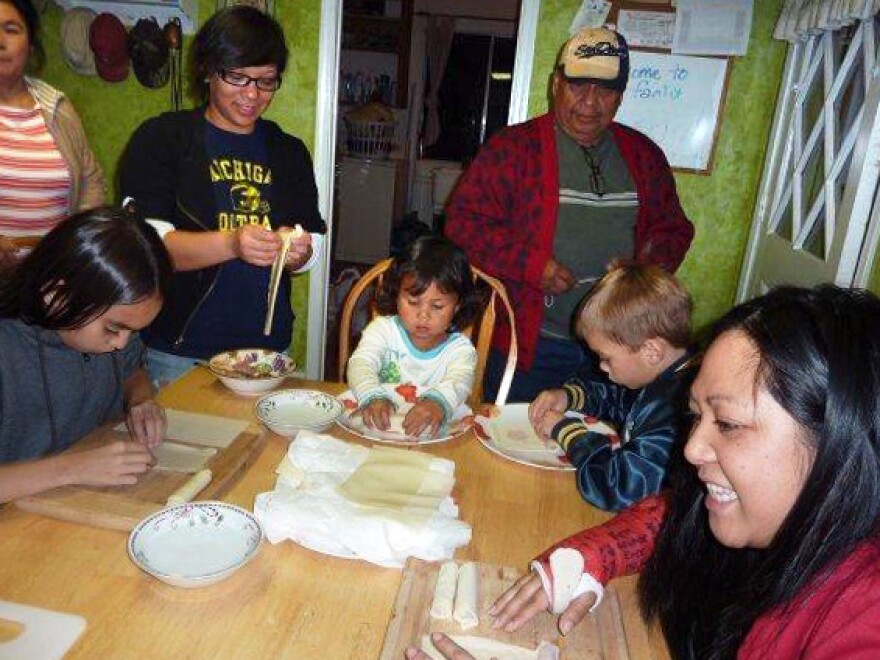NPRcontinues a series of conversations about The Race Card Project,where thousands of people have submitted their thoughts on race and cultural identity in six words. Every so often NPR Host/Special Correspondent Michele Norris dips into those stories to explore issues surrounding race and cultural identity forMorning Edition.
The Race Card Project gets a lot of submissions that reference the family table and the ties among food, family traditions, culture and ethnicity. Take this one from Melanie Vanderlipe Ramil of Sacramento, Calif.: "I ate pasta, family ate rice."
Ramil's parents were Filipino immigrants, and in their household, rice was part of every meal. Her family used so much rice, Ramil says, they couldn't keep it in the cupboard. Instead, the centerpiece of the kitchen was a 4-foot-tall dispenser that held 50 pounds of rice.
"I never knew life without it in my parents' kitchen," Ramil says. "The bottom has a drawer. ... After you press your one, two or three cups, you'd pull the drawer out, and there — you're ready to make rice in your rice cooker.
"But my friends would come over and they would ask me what that was and be perplexed by it," she says. "And I was confused right back at them, not knowing why they wouldn't know what a rice dispenser was."
Growing up, Ramil says, she "wanted to be as non-Filipino as possible and felt great achievement whenever friends said to me, 'You seem so white!' "
She was embarrassed when her friends came over and she couldn't offer them pizza, hot dogs or Tater Tots to eat.
"I just know that growing up, I had moments where I rejected Filipino culture," Ramil recalls. So when she reached middle school, Ramil told her parents that she didn't like rice.
Ramil's mother didn't object. "My mom, after rushing home from work to cook dinner for us every day, relented and lovingly prepared pasta for me while the rest of the family ate rice," Ramil recalls.
"I just remember her scrambling in the kitchen. I always remember her coming home from work, still wearing her work clothes, with an apron ... running around making a hot meal every night for our sit-down family dinner," Ramil says.
"And then she would pull out my Pasta Roni box and prepare this processed pasta dish because I claimed not to like rice."

Her parents wanted their children to succeed in America, Ramil explains, and were trying to help them assimilate.
Now 31, Ramil cringes a bit when she recounts the story. In fact, she wishes she had spent more time in the kitchen with her mother, learning the family dishes.
She credits a course she took in college, Filipino American Contemporary Issues, for her change in perspective. "That dinky little class, that I thought would be nothing ... changed my life and my connection to identity," Ramil says.
Today, Ramil's extended family is made up of more than 100 people. Many of her cousins have married non-Filipinos. And now it's Ramil — who once rejected rice — who's trying to keep her family's food traditions alive.
She started with lumpia, which she describes "as an eggroll, but better." Her grandmother, Fausta Reyes Ramil, who lived to be 100, taught Ramil how to make the fried rolls, filled with pork and finely chopped vegetables, before she passed away. (Ramil also has a blog with her grandmother's journal entries, called Lola's Journals.)
Now, Ramil is making sure the young people in her family know how to make the traditional dish.
"I would prepare my grandmother's lumpia recipe and kind of set up a lumpia sweatshop, if you will," Ramil says. "For each of my cousins' children ... there are about 25 or 30 of them — I would put a place mat in front of them, lumpia wrappers ... a little bowl of raw meat."

"It's a really neat time, because while they're rolling, I'll bring in my older cousins, my aunts and uncles, and all of them — they just love it," she says. "We just all talk about stories of my grandmother cooking, our family. ... I just love the tradition."
The irony of being the champion of her family's culinary traditions isn't lost on Ramil. And while her mother didn't resist her request for Pasta Roni all those years ago, Ramil hopes that she'll handle a similar request differently.
"One day, if I'm a mom, and I hear my daughter say that, I might push back a little — and I hope I do."
Do you have a family food tradition you're trying to preserve? Send your "endangered dish" stories to thesalt@npr.org.
Copyright 2021 NPR. To see more, visit https://www.npr.org. 9(MDAxNzg0MDExMDEyMTYyMjc1MDE3NGVmMw004))






